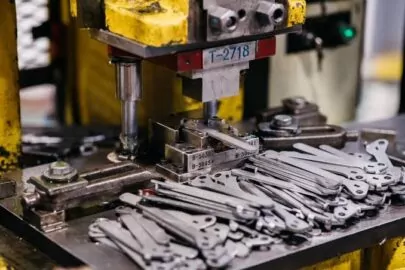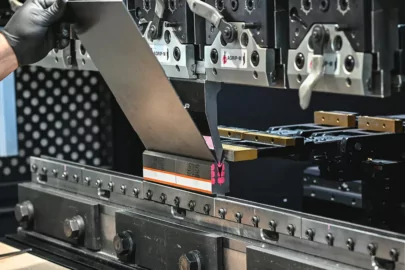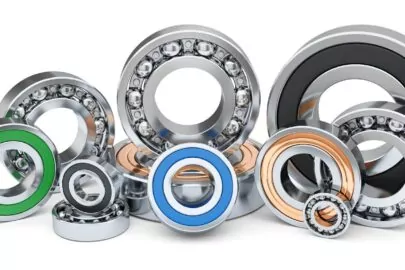Tapping and reaming are essential machining processes used in a wide range of industries, from automotive to aerospace. While both involve working with holes, their purposes and techniques differ significantly.
Tapping creates internal threads, allowing fasteners to be screwed into the hole, while reaming is used to precisely enlarge or finish an existing hole, achieving tight tolerances and smooth finishes.
Choosing between these processes depends on the specific project requirements, such as whether threading or precision sizing is needed. Understanding their differences is key to achieving the desired outcomes in any fabrication or assembly process.
In this article, we’ll explore the differences between tapping and reaming by examining their features, symbols, processes, and applications. We’ll also provide a detailed contrast table to illustrate their distinctions further.
Tapping vs Reaming: Differences Comparison

Tapping and reaming are essential machining processes, each serving unique purposes in manufacturing and fabrication. While both involve modifying pre-drilled holes, their outcomes and techniques differ significantly.
Tapping creates internal threads within a hole, enabling screws or bolts to be securely fastened, making it crucial in assembly work. This method is fundamental for creating threaded connections and ensuring secure fittings in various mechanical systems.
Reaming, on the other hand, is used to refine an existing hole by enlarging and smoothing it to achieve precise diameters and surface finishes. It enhances the accuracy and quality of the hole, which is essential for applications requiring tight tolerances and a smooth surface.
Understanding the differences between these processes is vital for selecting the right method based on the requirements of your project, such as precision, strength, and functionality. Each process offers distinct advantages depending on the desired outcome and specific needs of the application.
Features
Tapping and reaming are used for different objectives in fabrication, each having unique characteristics. Tapping involves cutting threads inside a hole for fastening purposes, while reaming is about perfecting a hole’s diameter for precision fits. Understanding their features helps identify their role in machining.
Tapping:
- Tapping is the process of cutting threads into a pre-drilled hole, allowing screws, bolts, or fasteners to engage with the material securely. Tapping is crucial in mechanical assemblies where components need to be fastened or removed multiple times.
- The tool used for tapping is a tap, which creates internal threads, either by hand or with machines.
- Tapping creates a spiral groove inside the hole, and different types of taps can be used for blind or through-hole threading.
Reaming:
- Reaming is a finishing process used to slightly enlarge and smooth the diameter of a pre-drilled hole, improving its accuracy and surface finish.
- A reamer is the tool used for this process, which typically has multiple cutting edges.
- Reaming is used to achieve precise diameters and smooth finishes, which are ideal for tight tolerance holes required in high-precision applications.
- Unlike tapping, reaming doesn’t involve creating threads; instead, it’s purely about sizing and finishing holes.
Symbol
In engineering and fabrication, tapping and reaming have distinct symbols used in technical drawings. These symbols convey critical information about hole size, threading, and tolerances, guiding machinists during production. Understanding these symbols is crucial for accurate communication between designers and manufacturers.
Tapping Symbol:
- In technical drawings, tapping is represented by a “Ø” symbol followed by the thread size and pitch (e.g., M8 x 1.25). This notation indicates the nominal diameter and pitch of the threads to be tapped into the hole.
- Threading information is essential in understanding the requirements for internal threading and helps machinists choose the correct tap and process.
Reaming Symbol:
- The symbol for reaming in engineering drawings is a simple Ø symbol followed by the finished hole’s size (e.g., Ø8 H7). The “H7” represents a tolerance grade for the hole’s diameter, indicating the precision required for the finished hole.
- Unlike tapping, the reaming symbol focuses solely on the size and tolerance of the hole without any reference to threading.
How to Tap a Hole vs Ream a Hole

Both tapping and reaming require specific methods to achieve their objectives. While tapping focuses on creating threads inside a pre-drilled hole, reaming fine-tunes the hole for diameter and surface quality. The techniques for each process ensure efficiency, accuracy, and suitability for different materials and projects.
How to Tap a Hole:
- Drill a Hole: Begin by drilling a hole slightly smaller than the tap’s diameter. The hole size is critical, as it must leave enough material for the tap to cut threads without weakening the part.
- Choose the Right Tap: Select a tap according to the thread size and material.
- Start Tapping: Insert the tap into the hole and turn it clockwise (for right-hand taps) using a tap wrench. Ensure that the tap is aligned with the hole.
- Cut Threads: Continue turning the tap, applying even pressure, and periodically reverse it to break off chips and prevent binding.
- Complete the Threads: Once the tap reaches the bottom of the hole, carefully back it out, leaving behind clean-cut threads.
How to Ream a Hole:
- Pre-Drill the Hole: The hole is first drilled slightly undersized to allow for the reamer to enlarge it.
- Select the Appropriate Reamer: Choose a reamer according to the desired final hole size and material type.
- Ream the Hole: Insert the reamer into the pre-drilled hole. Rotate the reamer while applying steady pressure. Reaming can be done by hand or machine, depending on the precision required.
- Finish the Hole: The reamer removes small amounts of material, leaving behind a smooth and precise hole with an excellent surface finish.
Applications
Tapping and reaming are employed across numerous industries, from automotive to aerospace, each serving distinct applications. Tapping is primarily used for fastening components with screws or bolts, while reaming is essential for precision hole sizing and achieving smooth finishes for tight tolerances.
Tapping Applications:
- Tapping is widely used in manufacturing and construction, where components are fastened with screws or bolts.
- Automotive and aerospace industries rely heavily on tapping for assembling metal parts.
- Tapping is also used in machinery production, electronics, and the construction of structures where threaded fasteners are essential.
Reaming Applications:
- Reaming is commonly used in industries where tight tolerances and high precision are necessary, such as in engine cylinder blocks, aerospace components, and hydraulic systems.
- It’s also used in producing precision parts like gears, shafts, and bearings that require smooth, exact holes for proper functioning.
- Reaming ensures the fit and alignment of components in high-precision assemblies.
Strength Considerations
Tapping and reaming are employed across numerous industries, from automotive to aerospace, each serving distinct applications. Tapping is primarily used for fastening components with screws or bolts, while reaming is essential for precision hole sizing and achieving smooth finishes for tight tolerances.
Tapping Strength:
- The strength of a tapped hole depends on the material being threaded and the depth of the threads. Stronger materials, such as steel or titanium, provide greater thread strength.
- Tapping provides a secure hold for fasteners in mechanical assemblies, making it ideal for load-bearing joints.
- The threads must be correctly cut to distribute the load evenly across the fastener, preventing stripping or loosening under stress.
Reaming Strength:
- Reamed holes do not affect the material’s strength but ensure a precise fit, which is crucial for high-performance assemblies.
- In applications like aerospace and automotive, the precision of reamed holes helps maintain the integrity and alignment of parts, indirectly affecting the overall strength and performance of the assembly.
- Reaming provides a smooth surface that ensures proper mating with other components, reducing wear and extending the life of mechanical parts.
Precision in Machining
Precision is key in machining processes, particularly with tapping and reaming. Tapping demands accurate alignment for proper thread formation while reaming focuses on perfecting the hole’s dimensions and surface finish to meet exacting tolerances, making both essential for precision engineering.
Tapping Precision:
- The precision of tapping depends on the accuracy of the pre-drilled hole and the quality of the tap. Poorly aligned taps can result in skewed threads, affecting the fit of the fastener.
- In applications where precision is key, such as aerospace or medical devices, high-quality taps, and accurate machining processes are essential to ensure reliable performance.
Reaming Precision:
- Reaming is a highly precise process, used to achieve tight tolerances within microns. The pre-drilled hole must be correctly sized for the reamer to achieve the desired final diameter.
- Reaming ensures that the hole is not only the correct size but also has a smooth surface finish, which is important in applications requiring perfect alignment and reduced friction.
Cost Considerations
Cost is a critical factor in deciding between tapping and reaming, as both processes involve different tool wear rates, time requirements, and operational expenses. Understanding how each method affects production costs is essential for budgeting and efficiency.
Tapping Cost Considerations
- Taps are relatively inexpensive and readily available, making tapping a cost-effective solution for creating threaded holes.
- Taps can wear out quickly, mainly when used on more challenging materials, increasing tool replacement costs over time.
- Tapping is generally faster than reaming, making it more cost-efficient in high-volume production.
- Tapping removes more material than reaming since it cuts threads into the hole, which could result in slightly higher material waste.
Reaming Cost Considerations
- Reamers are typically more expensive than taps due to their precise design and high-quality materials.
- Reamers have a longer tool life compared to taps, as they remove less material and experience less wear during the process.
- Reaming is slower and requires more machine time, which can increase the overall production cost in high-volume operations.
- The higher cost of reaming is justified by the precision and superior finish it delivers, particularly in high-tolerance applications.
Material Suitability
The type of material being machined plays a significant role in choosing between tapping and reaming. Some materials are more accessible to thread, while others require more precise hole refinement, affecting tool performance and final product quality.
Tapping Material Suitability
- Tapping works well with more rigid materials such as steel, but these materials can cause faster tool wear.
- Softer materials like aluminum and plastics can be tapped with ease, though the thread quality might be lower without precise control.
- Brittle materials like cast iron pose a challenge for tapping as they can crack under the stress of cutting threads.
- Tapping is less effective in exotic alloys due to the difficulty in creating clean threads and the potential for tool breakage.
Reaming Material Suitability
- Reaming is highly effective in more complex materials like steel, providing precise and smooth hole finishes without damaging the material.
- Reaming works well with softer materials, ensuring clean, accurate holes and reducing the risk of material deformation.
- Reaming is preferable for brittle materials since it applies less force, reducing the risk of cracking or fracturing.
- Reaming is often used in exotic alloys where precision is critical, providing a high-quality finish without extensive tool wear.
Contrast Table
| Feature | Tapping | Reaming |
| Purpose | To create internal threads | To enlarge and smooth a hole |
| Tool Used | Tap | Reamer |
| Material Removal | Removes material to form threads | Removes small amounts for accuracy |
| Symbol in Drawings | Ø with thread size (e.g., M8) | Ø with size and tolerance (e.g., Ø8 H7) |
| Precision | Moderate, depending on the hole size | High precision for tight tolerances |
| Application | Fastening components with screws | Precision hole sizing in parts |
Conclusion
Tapping and reaming serve different purposes in machining and fabrication. While tapping focuses on creating threads for fasteners, reaming ensures precision in hole sizes and finishes. Both processes are essential for various industries, including automotive, aerospace, and manufacturing. If your project requires high precision, threading, or hole finishing, understanding these processes is crucial for successful outcomes.
Zintilon, a leader in metal fabrication and machining, provides expert tapping and reaming services for all your project needs. Their experienced team ensures top-quality results, whether you require precision threading or high-tolerance reamed holes. Trust Zintilon for reliable, efficient solutions in all your machining projects.
Great, Together



